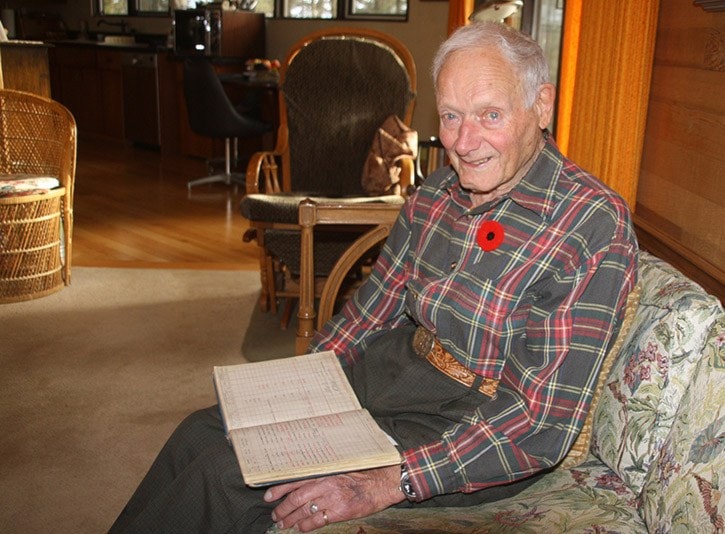Frank Burgess of Williams Lake said the Distinguished Flying Cross he received in 1943 was because he was very lucky.
Reflecting on his experiences as a Second World War pilot the Wednesday before Remembrance Day, the 93-year-old said he lost so many friends in the war.
“I had only been with the Royal Air Force Squadron 61 Group 5 Bomber Squad about one week when I realized it was a hopeless case,” he recalled.
Fetching his treasured pilot’s log book from a bookshelf in his living room, Burgess turned to an entry he made on Dec. 16, 1943.
That’s the day that resulted in his DFC medal.
“I was a pilot in charge of an aircraft detailed to attack Berlin,” he recalled. “I got the award because I carried on when I could have turned back.”
Two hundred and fifty miles from the target, one of the four engines on the Lancaster he was flying quit.
Instead of turning back, Burgess persisted and the crew made a successful attack.
When Burgess returned to the Swinderby base at 12:30 a.m, an air marshal was waiting to give him the medal right then and there.
Originally from Drumheller, Alta., Burgess was working at the Copper Mountain Mine near Princeton when he decided to enlist.
“It looked like we were going to lose Britain, so in the early part of 1942 I joined the air force,” he said. He was 22 years old at the time.
Up to that point he hadn’t flown an aircraft so he embarked on a year of flight training, eventually soloing in a Tiger Moth.
“Tiger Moths and Lancasters were my favourite to fly,” he smiled.
Once the training was completed in early 1943, he was assigned to the 61 Squadron and began a seven-month-tour of bombing operations in a number of little places, mostly in the middle of England.
“I was fortunate to come through OK,” Burgess said. “No one had ever finished a tour there on that 61 Squadron. They just kept on going missing.”
Turning to an entry in the log book for March 22, 1944, Burgess described an attack by a Messerschmitt 109 right over the target at Frankfurt.
“This guy was so intent on shooting us out and kept getting closer and closer,” Burgess recalled. “He let his cannon go and it went right over my head, maybe a foot over the top of the plane.”
Because the other plane was so close, Burgess’s gunner was able to shoot and the enemy plane exploded.
A Lancaster crew consisted of a pilot, wireless operator, navigator, rear gunner, mid gunner, flight engineer and bomb aimer.
The bomb aimer was the only other Canadian on the crew, Burgess said.
“We called him Junior Steadman. They called me Skipper.”
A typical operation day began at 4:45 p.m. because by the time the plane had climbed to 22,000 feet and was flying over enemy territory it was dark, he explained.
When they opened the door to let off a bomb, a camera on the plane would take a photograph. One day a British newspaper ran a photograph taken by Burgess under the headline: “Lancasters over Berlin.”
Cameras had been installed in planes because early in the war, some of planes were dropping bombs in the sea because crews didn’t want to bomb German people.
“Of course none of us liked to bomb and kill people, but the war had to be won,” Burgess said. “When they opened the bomb bay, the camera took the time and everything so they could estimate where we were.”
During one flight in March, 1944, when they hit the coast of Europe, his bomb aimer was laying on his stomach in the front of the aircraft ahead of Burgess.
“He could see below and he said to me, ‘Skipper, we’re way off course,’” Burgess recalled. “He said he could tell by the coast line because it’s just like a white line, even in a dark night, it’s the sea breaking on the shore. He said we were about 30 degrees off course.”
Burgess altered course about 35 degrees to aim for Nuremburg.
“Many of the crews that didn’t notice that just kept going, and once they realized and had to turn around, they ran out of petrol on the way home to England.”
The enemy estimated 92 losses that day, but it was actually 103 counting the ones the Germans didn’t know about that never got back and were lost to the sea, Burgess said, shaking his head.
In the end, his crew survived and after the war got together for three reunions.
The first was in England at the Flying Horse Hotel where they often stayed during the war. The second was in Spain where the Canadian bomb aimer moved to after the war, and the third reunion was back in England.
“The last reunion was 35 years or so ago,” Burgess said.
Eventually the crew members lost track of each other, although Burgess and his wife Norma still correspond with the wife of the rear gunner.
“I was best man at their wedding during the war,” Burgess said. “I think I am the only one of us alive now though.”
His crew was lucky, he said.
“The losses were so heavy.”
Burgess met his wife Norma at Copper Mountain where he returned to work after the war.
They were married in 1950 and after living in a few communities arrived in Williams Lake in 1953, where they’ve been ever since.
